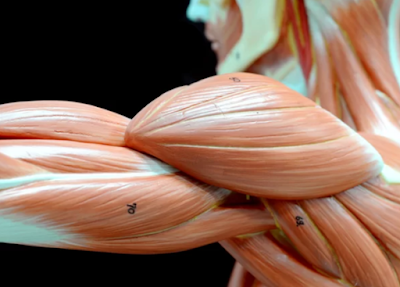Scientists have created tiny artificial human muscles that contract and respond to neural and electrical stimuli just like real muscles do, a new study reports. There's just one twist: The functioning muscle fibers were made from skin cells, not muscle cells.
Previously, scientists have been able to make muscle cells from other types of cells; however, no one so far has managed to make functioning muscle fibers from anything other than muscle cells. (Muscle fibers are groups of muscle cells.) The successful experiment, detailed in an article published today (Jan. 9) in the journal Nature Communications, could help researchers better study genetic muscular dystrophies, and test new treatments.
In the study, the researchers beganby taking cells from skin samplesfrom humans. They used a known technique to turn these cells into so-called induced pluripotent stem cells — cells that can transform into any type of human cell. Then, using a new method they developed, the scientists were able to turn these pluripotent stem cells into muscle stem cells, which are called myogenic progenitors. [5 Amazing Technologies That Are Revolutionizing Biotech]
"We take these induced pluripotent stem cells made from a person and then we make them into muscle cells by having them express a protein called Pax7, which signals to the cells to change into muscle cells," said senior study author Nenad Bursac, a professor of biomedical engineering at Duke University in North Carolina. "It takes about three weeks until they become reprogrammed."
Using just one pluripotent stem cell taken from a donor, the researchers can create thousands of muscle stem cells, Bursac told Live Science. This is because once turned into muscle stem cells, these cells can multiply further.
Once the scientists had sufficient muscle stem cells to work with, they switched off the Pax7 protein (the one that signals for them to transform). Then, the muscle cells were placed in a 3D culture that contained various nutrients and growth factors that stimulate the cells to organize into muscle fibers.
After another three weeks, pieces of muscle tissue up to 2 centimeters (0.8 inches) long, almost 1 millimeter (0.004 inches) in diameter, formed in the solution, Bursac said.
Then, the tests begin. "We can subject these muscle tissues to all the classical physiological tests that you can measure in animals or in humans," he said.
In this study, Bursac's team built upon a breakthrough they had achieved three years ago, when they became the first team in the world to make functioning human muscle fibers from cells taken from muscle biopsies. But compared to those earlier samples, the fibers made from skin cells are considerably weaker, Bursac said. This is something his team wants to address in their future work, he added.
Who needs new muscles?
The development could significantly improve researchers' ability to study genetic muscular diseases, such as Duchenne muscular dystrophy, which affects 1in 3,600 male infants worldwide. People with Duchenne muscular dystrophy start having muscle weakness at about age 4. The condition quickly progresses and by age 12, the patients lose their ability to walk. Most die by age 26, according to available estimates.
"In genetic diseases in pediatric patients the muscles are already damaged and it's not good for them if we take biopsies," Bursac said. "This method allows us to generate muscle samples from their skin or blood samples." [Meet Your Muscles: 6 Remarkable Human Muscles]
Since the fibers that the scientists created in the study are fully functioning, the researchers can now study how they respond to various treatments, Bursac said.
"By being able to form functioning muscle, we can really study various parameters and see whether certain therapies can lead to improvement in muscle strength and muscle contraction," Bursac said. "We hope that this will be more predictive than animal studies."
Bursac noted that some drugs that work in mice could be toxic for humans. Having such artificial human muscle fibers would therefore streamline the development of new safe treatments, he said.
Still, the muscle fibers the researchers grew in the lab were quite small. The size of the muscle fibers that can be grown is currently limited because bioengineers are not able to create vessels long enough to support larger samples than a centimeter or two, Bursac said. This hinders the entire bioengineering field, he added.
He hopes the technique could possibly be used in the future to re-engineer a patient's damaged cells into healthy cells and use the resulting muscle fibers to improve the patient's quality of life.
"Because of the size limit that we have, we cant use this to treat big muscle injuries," Bursac said. "But if there is a localized injury, particularly to specific muscles, then tissue engineering applications as this one could be used for the local repair of the muscle."
Working Human Mini Muscles Grown from Skin Cells in Scientific First
 Reviewed by Unknown
on
January 17, 2018
Rating:
Reviewed by Unknown
on
January 17, 2018
Rating:
 Reviewed by Unknown
on
January 17, 2018
Rating:
Reviewed by Unknown
on
January 17, 2018
Rating:













No comments: